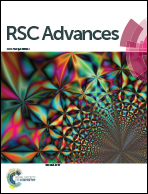A sensitive OFF–ON–OFF fluorescent probe for the cascade sensing of Al3+ and F− ions in aqueous media and living cells†
Abstract
A simple Schiff-base ligand 2-hydroxy-1-naphthaldehyde semicarbazone (HNS) was synthesized and characterized. Based on the combined effect of inhibition of CH![[double bond, length as m-dash]](https://www.rsc.org/images/entities/char_e001.gif) N isomerization and chelation-enhanced fluorescence (CHEF), HNS functions as a fluorescence “turn on” sensor for Al3+ in buffered aqueous media. Based on the strong affinity of Al3+ to F− ions, the in situ generated Al3+–HNS complex can also be utilized as an effective chemosensor for F− sensing by metal displacement approach, ensuing quenching of fluorescence by the reversible return of HNS from Al3+–HNS complex. Thus a method using a single probe for the detection of both Al3+ and F− ions is developed. The system exhibits high selectivity and sensitivity for Al3+ and F− ions and the detection limits were found to be as low as 6.75 × 10−8 M and 7.89 × 10−7 M, respectively. Furthermore, the practical applicability of this probe has been examined in living cells.
N isomerization and chelation-enhanced fluorescence (CHEF), HNS functions as a fluorescence “turn on” sensor for Al3+ in buffered aqueous media. Based on the strong affinity of Al3+ to F− ions, the in situ generated Al3+–HNS complex can also be utilized as an effective chemosensor for F− sensing by metal displacement approach, ensuing quenching of fluorescence by the reversible return of HNS from Al3+–HNS complex. Thus a method using a single probe for the detection of both Al3+ and F− ions is developed. The system exhibits high selectivity and sensitivity for Al3+ and F− ions and the detection limits were found to be as low as 6.75 × 10−8 M and 7.89 × 10−7 M, respectively. Furthermore, the practical applicability of this probe has been examined in living cells.



 Please wait while we load your content...
Please wait while we load your content...